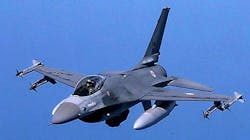DOD officials choose Exelis to provide EW jammer pods to Turkish air force F-16 jets in $75.3 million contract
Exelis will provide 21 ALQ-211(V)-9 AIDEWS pods, support equipment, countermeasures dispensing system integration, and spare parts for Turkish F-16D Block 50s. Awarding the contract were officials of the U.S. Air Force Life Cycle Management Center at Robins Air Force Base, Ga.
The ALQ-211(V)-9 electronic countermeasures pod provides digital radar warning, high power jamming, threat geolocation, and situational awareness, and is modular and scalable for systems upgrades and technology insertion, Exelis officials say.
Exelis won another sizable EW contract just last week when the U.S. Navy ordered 42 of the company's AN/ALQ-214(V)4 on-board jammer systems for the F/A-18C/D and F/A-18E/F Hornet and Super Hornet carrier-based strike fighters in a $91.7 million contract.
The F-16 is for close air support and battlefield area interdiction, strike, suppression of enemy air defenses, and defense and interceptor missions. The F-16's ALQ-211 AIDEWS variant provides an internal, integrated radar warning and RF countermeasures capability.
Pre-flight, the ALQ-211 enables air crews to download local order of battle threat information, along with on-board, real-time links to other intelligence systems to enable the aircrew accesses to an updated threat lay-down, Exelis officials say.
Maneuvering during the mission, the ALQ-211’s sensitive receiver and threat identification processing helps the air crew assess threats, identify enemy emitters, and pinpoint their locations beyond lethal range. The system samples the RF environment, and integrates RF, infrared, and laser threat data to provide the air crew with a consolidated picture of dangerous areas.
When the air crew encounters a threat emission, the ALQ-211 determines how far away it is by analyzing the threat ID, lethality, mode of operation, and its changing angle of arrival to the aircraft.
This helps pilots replan missions to avoid threats, if necessary, and use terrain masking to avoid detection and navigate away from danger. The system also can hand off threat locations for later targeting.
If an aircraft is in lethal range, the ALQ-211 can break missile lock through RF countermeasures and deploys chaff and flares, as well as coordinates the response for laser and IR threats. Mission threat data can be updated through the ALQ-211 for use in future engagements in-flight via tactical data links.
The Exelis ALQ-211 EW systems also are installed aboard military attack, utility, and scout helicopters and the CV-22 Osprey tiltrotor aircraft.
On this contract Exelis will do the work in Clifton, N.J., and should be finished by May 2017. For more information contact Exelis Electronic Systems online at www.exelisinc.com/business/electronicsys, or the Air Force Life Cycle Management Center at Robins Air Force Base at www.robins.af.mil/units/aflcmc.
About the Author
John Keller
Editor-in-Chief
John Keller is the Editor-in-Chief, Military & Aerospace Electronics Magazine--provides extensive coverage and analysis of enabling electronics and optoelectronic technologies in military, space and commercial aviation applications. John has been a member of the Military & Aerospace Electronics staff since 1989 and chief editor since 1995.
